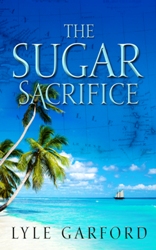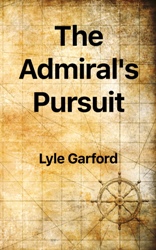 Pirates and Privateers Pirates and Privateers
The History of Maritime
Piracy
Cindy Vallar, Editor
& Reviewer
P.O. Box 425,
Keller, TX 76244-0425
    
Books for Adults ~ Nautical Fiction
& Historical Fiction & Historical
Mystery
Dockyard Dog
The Sugar
Revolution
The Sugar
Sacrifice
The Sugar
Rebellion
The Sugar
Inferno
The Admiral's
Pursuit
The Sugar
Sands
The Sugar
Storm
The Sugar Winds

Dockyard Dog
By Lyle Garford
Lyle Garford, 2016, ISBN 978-0993617386, US $13.35 /
CAN $18.43
Available in various formats
    
Not even a year has passed
since the American Revolution when
twenty-two-year-old Evan Ross steps aboard
HMS Wind as the new Third
Lieutenant. Being assigned to a frigate is
every officer’s dream, but it’s been three
months of hell; the Admiralty ignored the
captain’s request and appointed Evan
instead. While the ship sails for England,
a Yankee smuggler is spotted unloading
cargo on Antigua. A direct violation of
the Order of Council – all trade between
the United States and the Caribbean
islands must be carried on British ships
with British crews – so Evan is ordered to
assist in capturing the smuggler. On
shore, he comes face-to-face with some of
his former shipmates, deserters from the
Royal Navy who have no intention of facing
punishment. A struggle ensues, during
which Master’s Mate James Wilton saves
Evan’s life. Their wounds are severe
enough that they are shipped ashore while
the Wind heads home.
Fed up with the continual violation of the
Order of Council and the resultant loss of
needed tariffs to fill the nearly bankrupt
royal coffers, the First Lord of the
Admiralty assigns his protégé a special
assignment. He must do whatever it takes
to put an end to the smuggling, regardless
of whose feathers get ruffled. At
twenty-five, Captain Horatio Nelson is
more than equal to the task, for he hates
to lose. With his men fully behind him,
they sail for Antigua to implement that
order, as well as two others. Nelson must
see that the desired expansions to the
dockyard are completed quickly, and also
gather intelligence on what the French are
doing in the Caribbean since war between
his country and France is inevitable given
the long animosity between them.
No one on Antigua is pleased with Nelson,
for his orders directly impact the
pocketbooks of influential sugar planters
and the corrupt men working in the
dockyard. The former have the wherewithal
to thwart him at every turn, and since
Nelson must also patrol the sea and confer
with his commanding officer on Barbados,
he needs someone he can rely on to assist
him.
During his recuperation, Evan becomes
frustrated in dealing with the loss of one
arm and with the lack of anything to do.
The navy seems to have forgotten about him
and James, who is recovering from a leg
injury. They spend many hours together,
and their friendship raises a few eyebrows
around the dockyard since ranks and
officers don’t usually interact except
when necessary. Nelson’s arrival seems
like a godsend, but they are disappointed
to learn there are no positions aboard any
of the naval ships. But Evan is just the
man to become Nelson’s representative at
the dockyard with full authority to
oversee that construction progresses
apace, and James is his assistant. They
are less comfortable with Nelson’s second
and secretive assignment – spying on the
Antiguans and gathering as much
intelligence as possible on the smuggling.
Frequent excursions to the Flying Fish, a
tavern operated by slaves, but owned by
one of the planters, provide Evan and
James the perfect place to begin their
espionage. The husband and wife who manage
the tavern and one of the ladies, with
whom Evan has become close, agree to help,
and their acquaintance with maroons
(escaped slaves) provides Evan and James
with many eyes. Two docked vessels flying
Dutch colors raise Evan’s suspicions,
because neither looks to be in distress
(as claimed) and neither captain – a
Frenchman and an American – strike him as
being merchants.
As the intelligence helps Nelson to clamp
down on the smuggling, the planters become
more riled since they’re losing profits.
Then a French sailor asks Evan’s
girlfriend if the slaves and maroons are
armed. Several months later, two
plantations are attacked and people are
murdered and, with Nelson’s successes, the
planters try a new tactic: offer Evan a
lucrative job with the smugglers. His
heart and soul belong to the navy, and he
has no intention of disappointing Nelson,
a man he likes and respects.
Dockyard Dog takes place between
June 1784 and June 1785, and is the first
volume in the Evan Ross series. Although
the majority of the action takes place on
land, readers who like tales of nautical
and historical fiction will enjoy this
story. Evan’s disability is not glossed
over, and his friendship with James, while
unusual for the time period, aptly
demonstrates that people can be friends no
matter what color their skins. Garford
brings Horatio Nelson to life and focuses
on a time in his life before he became the
legendary commander who sacrificed his
life to save England. In spite of the 425
pages, Dockyard Dog is a
fast-paced read filled with action and
intrigue. I look forward to reading Evan’s
next adventure, The Sugar Revolution.
Review Copyright ©2016 Cindy Vallar


The Sugar Revolution
By Lyle Garford
CreateSpace, 2016, ISBN 978-0-9952078-0-6, US
$13.99
Available in
various formats
    
Three
years have passed since Commander
Evan Ross and Lieutenant James
Wilton thwarted the smuggling on
Antigua. Much of their time has been
taken up by dockyard business and
both are eager for more stimulating
work. They long to once again serve
on vessels of the Royal Navy, but
England remains at peace and there
aren’t enough ships for all the
officers to serve on. Illness and an
inability to curb a prince’s
manipulative behavior result in
Captain Horatio Nelson being called
home in late 1786, and Evan and
James await the arrival of a new
commander of the Leeward Station.
By the summer of
1787, France is in crisis. There’s
no work. The harvests have failed.
Robbers plague the countryside and
cities. Some of the nobility
realize reform is necessary, and
the Marquis de Lafayette invites
members of wealthy and influential
families to his home in hopes of
getting them to suggest and work
on the changes. One guest is
twenty-four-year-old Count Anton
de Bellecourt, who believes that
going to the colony of St. Lucia
will help in this regard. If he
can persuade the other sugar
planters to find more innovative
and cost-saving ways to harvest
the sugar and free their slaves so
they can earn a living, these
reforms will stimulate change in
the French government. Lafayette
wants peaceful reform, but Anton
is willing to spill blood to
achieve his goal if necessary.
Which is why the ship he hires to
transport him and his family to
the Caribbean island is captained
and crewed by rogues and the ship
carries a secret cargo (guns).
Captain Rand, Evan’s
new boss, finally arrives in 1788,
bringing with him Captain
Standish, the man charged with
gathering intelligence in the
Caribbean. As far as Rand is
concerned, he sees little need for
spies and blames the French for
every wrong. Standish thinks
differently and the presence of
five French Royal Navy vessels at
St. Lucia worries him. So does the
fact that he has heard nothing
from his agent there in three
months. With the help of Antigua’s
governor, Standish persuades Rand
to provide Evan with a vessel so
he can track down the agent and
get a report. At the same time, he
is to assess the military forces
on St. Lucia.
Soon after Evan, his
girl friend Alice, and James
arrive on the island, they learn
the agent has been murdered. His
killer is unknown. Evan also meets
Anton de Bellecourt; the more Evan
learns, the more he suspects that
something may be off where the
count is concerned. Evan finds an
unlikely ally in a man who was
once his enemy, and Evan and
Captain Marchel Deschamps of the
French navy work together to
uncover the truth behind the
mysterious count, the arming of
runaway slaves, and the violence
affecting Antigua and several
French islands. The task is far
more dangerous than anyone
suspects, for someone has an
agenda all his own and, if
successful, no whites will be left
alive.
The Sugar
Revolution is the second
book in the Evan Ross series.
Several scenes, including one
involving gun smugglers, take
place on ships, but the majority
of action occurs on St. Lucia and
Antigua. Unlike the first book,
the coupling between characters in
this story seems excessive
(although that is a personal
opinion). The plot is complicated,
yet Garford does a seamless job
weaving the various threads
together so the reader has a clear
understanding of events and the
political situations affecting
what occurs at home and in the
colonies. The action keeps the
reader enthralled, and I look
forward to reading Evan’s next
adventure.
Review Copyright ©2016 Cindy Vallar


The Sugar Sacrifice
By Lyle Garford
Lyle Garford, 2017, ISBN 978-0-9952078-2-0, US
$13.99
Available in various
formats
    
When Baron Jean
Baptiste Raimond La Chance arrives
in St. Lucia in December 1792, he
introduces the innovative
guillotine to the enlightened
citizens of the French island. His
assistants, who arrived earlier,
are agents who explained the
rights of man to the slaves and
confiscated any property belonging
to royalists. He should deal with
two consequences of freeing the
slaves – the decrease in food and
sugar production – but he’s more
interested in punishing anyone who
impedes the Revolution’s agenda.
His first target is Marchel
Deschamps. Not only is this naval
officer a traitor, who refuses to
divulge where a cache of gold is
hidden, but his father was
responsible for ruining La
Chance’s family. Once La Chance
learns all he needs to know from
Deschamps, the traitor has a date
with Madame Guillotine.
The
summons from the British
spymaster in the Caribbean is a
welcome diversion from the
normal routine of running the
Navy Dockyard on Antigua, but
Commander Evan Ross and
Lieutenant James Wilton also
know it means they must risk
their lives once again for king
and country. The turmoil in
France has had a ripple effect
that has now spread to their
backyard; with no word from St.
Lucia, they are ordered to go to
the island, locate Deschamps,
find out what’s going on there,
and rescue him if necessary.
Speed is of the essence, but
with war on the horizon between
England and France, they are
hampered in quickly leaving
Antigua. Nor can a British
warship just sail into the
French port, so they must
convert a navy ship to an
American trading vessel,
disguise themselves as traders,
and acquire a handpicked crew
that includes not only seamen,
but also a lock picker, a
forger, and a burglar. Also
accompanying them is Manon,
James’s girlfriend, who grew up
on St. Lucia and whose father
still lives there. While on St.
Lucia, she and her father
disappear and the attempt to
rescue Deschamps is derailed.
Out of options, Evan returns to
Antigua for more help, but James
remains behind to search for
Manon.
The
Sugar Sacrifice is a
roller coaster of excitement
that has readers sitting on the
edges of their seats and holding
their breath. It’s a stunning
tale of consequences, courage,
loyalty, and heartache into
which rays of hope still beam.
Some readers may not gain a full
understanding of the title until
the Author Notes at the end,
even though Garford hints at the
reason early in the story.
Others may find the violence
difficult to read, but it is
historically accurate and never
gratuitous. Garford achieves
what all historical novelists
strive toward – portraying
history in a way that makes it
come alive and puts readers in
the midst of the action. In
fact, the horrors of the
guillotine are so vivid readers
hear the blade drop. Whether
newcomers to the series or
already fans, readers of this
third book in the Evan Ross
tales will find this one as
entertaining as the first and
eagerly await the forthcoming
title, The Sugar Rebellion.
Review Copyright ©2017 Cindy
Vallar


The Sugar Rebellion
By Lyle Garford
Lyle Garford, 2018, ISBN 978-0-9952078-4-4,
US $13.99
Available in various formats
    
Grenada is a
dangerous place on which to
live in 1795, especially if
you are English and white,
particularly if you are Ninian
Home, the governor. Originally
colonized by the French, the
English acquire the island as
a prize of war, but British
politicians have shown little
regard for these people’s
interests and even less for
the mulattos and slaves. One
of the latter is Julien Fedon,
a plantation owner whose
father was white and mother
was a former slave. His
position within the original
colonists, his influence among
the free mulattos, and his
land make him the ideal
candidate to lead a rebellion.
The day to strike comes in
March when Governor Home
ventures from the safety of
St. George. If they can
capture him, as well as other
wealthy English families, the
rebels can use them as
bargaining chips to gain their
demands.
Crippling
wounds ten years ago nearly
ended the Royal Navy careers
of Evan Ross and James
Wilton until Horatio Nelson
offered them the opportunity
to work for the British
spymaster in the West
Indies. They have become
adept at what they do and
the war with France makes
their services much in
demand. Their most pressing
assignment concerns the
rebellion on Grenada, which
has reached a stalemate
after ten months. They are
to assist the acting
governor and an incompetent
colonel in the Royal Army to
bring about an end to the
situation. Against his
better judgment, Evan allows
his wife, a former slave, to
accompany him because she’s
good at making friends,
discovering tidbits of
information, and not getting
caught. One of her first
revelations is that a female
rebel may be sneaking into
and out of St. George to spy
on the British.
A two-fold
problem faces Evan and
James. They no established
network of underground
contacts, and the acting
governor fears that time is
running out for the hostages
(forty men, women, and
children). The direness of
the situation compels James
to offer to infiltrate the
rebels. If he’s caught, he
will most likely die, but he
has one advantage over all
those privy to their plan.
He’s black. When added to
his friend’s skill with
weapons and a passing
knowledge of French, Evan
realizes that James might
just succeed.
The rebels are
leery of the Royal Navy
deserter and one yearns to
kill him outright. Julien
enlists the aid of his
female spy, who may do
whatever she must to
ascertain the truth – a
painful, but necessary
condition since he is in
love with Sophie Ventour.
When James meets Sophie, she
awakens feelings he thought
long dead. Each day becomes
a tightrope to walk where
his heart must battle his
conscience, as well as the
French spies who are helping
the rebels and Sophie’s
brother, the rebel who wants
to kill him.
The Sugar
Rebellion is a
fast-paced depiction of an
actual, but little known,
uprising. Garford could have
delved deeper into the
psychological ramifications
that Evan, James, and Sophie
face in their line of work,
but his rendering of
infiltration and spying
deftly unfold. Fans of the
Evan Ross series will enjoy
this fourth book that brings
to life this Grenadian
rebellion from differing
points of view and
demonstrates that events are
never just black or white or
that honor is neither
colorblind nor restricted to
one gender.
Review Copyright ©2018 Cindy Vallar


The Sugar Inferno
By Lyle Garford
Lyle Garford, 2019, ISBN
978-0-9952078-6-8, US $13.99
Available in various formats
    
With
little information
divulged in his
orders, Commander
Evan Ross arrives
at the Admiralty
in London for a
meeting in
February 1798. He
finds himself amid
august men – the
First Lord of the
Admiralty, the
Chancellor of the
Exchequer and
former Prime
Minister, and the
Foreign Secretary
– as well as his
immediate superior
and spymaster,
Captain Sir James
Standish, and
General Thomas
Maitland of the
Royal Army.
Something must be
done regarding the
volatile situation
in Saint Domingue
and Evan provides
vital firsthand
knowledge of what
he and his men
have learned in
dealing with the
many factions on
the island.
The
British first
intervened in the
chaos there five
years before, but
have yet to
achieve any of
their three goals:
stop the flow of
money to France,
prevent Spanish
intervention, and
gain a trading
partner that will
fill their own
coffers. The
British have
invested too much
to simply walk
away, but the war
with France
impedes their
ability to provide
additional funding
and troops. In
short order Evan
explains that
yellow fever, the
sheer numbers
pitted against
them, and devious
and intelligent
leaders, who ally
when necessary and
betray each other
when not, make it
extremely
difficult to forge
the necessary
alliances. Further
complicating the
situation are
those who wish the
status quo of
slavery to
continue and those
who do not. Then
there’s the
question of who
governs Saint
Domingue – those
who live there or
men sent from
France’s
Directory? The two
principal leaders
are Toussaint
L’Ouverture, a
mulatto who wants
to end slavery yet
allows it to
continue, and
Andre Rigaud, a
mulatto who cares
little for whites
or blacks and
believes mulattos
should govern not
only the island
but also the
world. Adding to
this volatile mix
are the Spaniards
who live on the
other side of the
island (Santo
Domingo) and would
like to control
the whole island.
France has no
intention of
abdicating
control; sooner or
later a new
administrator will
arrive and he may
not come alone.
The Americans also
want a piece of
this lucrative
pie.
News
arrives that the
black armies have
attacked two key
British forts; the
loss of one can
allow these armies
to reach
Port-au-Prince.
With all this
knowledge, the men
in power decide
that the original
objectives will
stand, but General
Maitland has final
say in how he
achieves them once
he arrives at
Saint Domingue and
assesses the
situation. Evan
will assist him in
that regard,
especially with
the assistance of
his best friend,
Lieutenant James
Wilton, who
currently spies on
the Spanish side
of the island, and
Midshipman
Baptiste, who has
infiltrated
Toussaint
L’Ouverture’s
inner circle to
become a trusted
advisor.
Of
course, the best
laid plans of the
British do not
coincide with
those of the
French. Theodore
Hedouville has
been sent by the
Directory to take
control of the
island with the
help of 300
soldiers, with
additional troops
being supplied by
the governor of
the Spanish side
of the island.
Accompanying him
are two spies,
Hubert Montdenoix
and Flemming
Linger, who return
to the Caribbean
to stir up
trouble, in hopes
that the French
will control not
only Saint
Domingue, but also
Jamaica.
Montdenoix also
searches for his
British
counterpart, a
one-armed man whom
he intends to put
out of business.
Once
again, Garford
deftly weaves a
gripping tale of a
complex situation
in a way that
makes it easy for
readers to
understand the
many diverse
historical
threads. The
Sugar Inferno
is the fifth book
in the Evan Ross
series, and while
it includes
details about the
workings of the
Royal Navy, its
primary focus is
on the important
tasks that naval
spies did and how
they did it.
Populated by many
rich characters,
some real and
others fictional,
each is diverse
and multifaceted
with human foibles
and frailties.
This fan looks
forward with eager
anticipation to
the next and final
adventure in the
series, The
Admiral’s
Pursuit.
Review Copyright ©2019
Cindy Vallar

 The
Admiral’s Pursuit
The
Admiral’s Pursuit
By Lyle Garford
Lyle Garford, 2020, print ISBN
978-1-7772783-0-4, US $12.99
Available in various formats
    
Shortly
after crowning
himself
emperor of
France,
Napoleon
Bonaparte
devises a
plan. Not
trusting his
naval advisers
to oversee its
deployment, he
sends orders
to several of
his admirals,
telling each
only what they
need to know
to carry out
single stages
of his
strategy – a
plan to which
no one else is
privy. He, the
most powerful
man in the
world, is
determined to
finally bring
about the
demise of his
nemesis, the
British, and
particularly
the Royal
Navy.
Admiral
Lord Horatio
Nelson, who
commands the
British naval
forces in the
Mediterranean,
is beyond
frustrated.
Two days ago,
the French
navy broke
through the
blockade of
Toulon and
vanished in
foul weather.
Determined to
break them
once and for
all, he must
pursue them,
but where? The
list of
possibilities
– Egypt,
Portugal, the
Caribbean, the
English
Channel –
precludes
venturing off
in any
direction
without some
clue as to
their
destination.
Yet no one has
seen even one
of their
ships.
Like
his English
counterpart,
Rear Admiral
Edouard
Burguês le
Comte de
Missiessy is
frustrated. He
commands a
French
squadron of
ships, but his
orders are
vague and the
ultimate goal
remains
unknown. He
receives three
sealed
envelopes
containing his
emperor’s
commands, but
he can only
open each at a
specific time
and place. The
first tells
him to sail
from
Rochefort,
France to
Spain where he
is to take
aboard a large
contingent of
soldiers. No
reason is
given. Nor do
the contents
of the second
envelope
provide
enlightenment.
They simply
provide him
with his next
destination
and a warning
not to open
the third
envelope until
after he
arrives there.
Admiral
Pierre-Charles-Jean-Baptiste-Silvestre
de Villeneuve
is unhappy and
troubled. His
orders tell
him to break
through the
British
blockade, but
the storm
permitting him
to accomplish
this feat
damages his
ships so much
that they must
return to
Toulon for
repairs.
Escaping the
blockade a
second time
will not be so
easy, but his
emperor’s
orders give
him little
choice in the
matter. Unlike
previous
orders, these
are strangely
silent on why.
Does this mean
Napoleon no
longer trusts
him? Or is
someone
setting him up
to fail? The
answers are
not
forthcoming,
and all he can
do is obey.
Best
friends and
fellow spies,
Captain Evan
Ross and
Commander
James Wilton
are desperate
to capture
Hubert
Montdenoix,
their
archrival in
the Caribbean,
who time and
again has been
a thorn in
their sides.
They finally
have that
chance on St.
Lucia, but the
firing of a
cannon alerts
the French spy
and he
escapes, even
though the
lookout’s
signal could
not have been
a warning
about Evan and
James’s
carefully laid
snare. Evan
has the
unsettling
feeling that
some other
danger is
afoot and it
isn’t long
before he
discovers what
it is. He is
also certain
that
Montdenoix is
behind the
many rumors
that keep him
from
pinpointing
exactly where
the danger
lies. This
makes it
doubly
important that
he and James
bring an end
to this man’s
interference
as soon as
possible.
This
last entry in
the Evan Ross
series takes
place between
December 1804
and November
1805, and
provides an
account of the
Royal Navy’s
chase of the
French fleet
from Europe to
the Caribbean.
Garford does a
commendable
job showing
the various
commanders’
frustration at
being hampered
by orders and
lack of
knowledge,
while making
this sometimes
muddy episode
in naval
warfare
crystal clear.
Evan and James
meet new
comrades in
arms, such as
Admiral
Alexander
Cochrane, and
renew old
acquaintances.
Horatio Nelson
devised the
plan that
allowed both
Evan and James
to remain and
excel in the
navy in spite
of their
disabilities.
In addition to
a tale of the
chase that
precedes the
Battle of
Trafalgar, it
also recounts
a little-known
episode in
naval history
about HMS Diamond
Rock, the
only rock to
be
commissioned
as a sloop of
war in British
naval history.
The
Admiral’s
Pursuit is
a fitting
conclusion to
this series,
and while Evan
and James will
be missed,
readers will
find the
ending
satisfying,
surprising,
and emotional.
Review Copyright
©2020 Cindy Vallar

 The
Sugar Sands
The
Sugar Sands
By Lyle Garford
Lyle Garford, 2021, ISBN
978-1-7772783-5-9, US $13.99
Also available various formats
Cashiered from the
Royal Navy after being found
guilty of trumped-up charges of
thievery, Owen Spence vows that
one day there will be a
reckoning with his accuser, a
member of the same family that
ruined his father. Until then,
he must find a new path in life,
preferably one involving the
sea. A beautiful innkeeper, with
whom Owen has an affair, helps
in this endeavor, and he soon
commands a sloop ferrying cargo
and passengers for a plantation.
The brutal treatment of the
slaves disturbs him, but he is
in no position to intervene and
desperately needs money to
survive. The monotony of his
work has him wishing for another
job – a real possibility when he
happens upon his uncle, whom he
hasn’t seen in years.
Alan
Giles runs a successful trading
company and seeks a new captain
for one of his vessels because
he wants to spend time with his
family on Barbados. Happening
upon his nephew is pure luck,
but the more they become
reacquainted, the more Alan
believes that Owen might be just
the man to replace him. And not
just in commanding the ship.
With his naval training and sea
experience, Owen can also
surreptitiously gather
information for the Foreign
Office. After all, Alan’s
trading ventures extend from
Boston to Porto Bello, and the
news he has acquired leads
himself and spymaster Sir James
Standish to believe that war is
in the offing. Should that
happen, it will be devastating
to the West Indies where more
sugarcane is produced than
foodstuffs.
This
first title in the Owen Spence
trilogy takes place between 1772
and 1775, but the series will
cover the entire span of the
American Revolution. The opening
scenes involving Owen and the
Royal Navy are quite visual and
easily capture the reader’s
attention. Once he’s dismissed,
the novel serves to set the
stage for the forthcoming books.
There is some action, as well as
an additional romantic angle –
both draw readers into the story
and make them care about the
characters – but the majority of
the book involves gathering
information and run-ins with a
shadowy French ship with an
American first mate, who is
related to the same radical
family that drove Owen’s first
mate out of Virginia. This setup
promises that when the final
confrontation comes between Owen
and his crew versus the
Frenchmen, more than sparks will
ignite. Equally propitious is
the expected comeuppance of the
family that destroys Owen’s
naval career.
Much
of the story consists of
dialogue; where action, such as
the raid on Bermuda or the
confrontation in a Boston tavern
where rebels meet, takes center
stage Garford keeps the reader
riveted. What makes The
Sugar Sands different from
other stories of the
Revolutionary War is its
perspective. It unfolds from a
Caribbean colonial viewpoint,
one rarely covered in works of
either fiction or nonfiction.
Garford also ably demonstrates
how the laws and tariffs that
England institutes set the
colonists on a war footing. The
story is more land-based than
sea-based, but incorporates
thought-provoking topics –
slavery, taxation, conflicting
loyalties – that remain relevant
today.
Review Copyright
©2021 Cindy Vallar

 The
Sugar Storm
The
Sugar Storm
by Lyle Garford
Independently Published, 2024,
ISBN 978-1-7772783-8-0, US $3.99
Available in various formats
Oranjestad on the
island of St. Eustatius in the
Caribbean has gone from a small,
unimportant town to a burgeoning
seaport where ships of all
nations come to trade. In late
1775, rumors of a smuggling
operation reach the ears of
spymaster Sir James Standish.
The colonists are not happy with
British dominance, and if the
French are supplying weapons and
ammunition to the Americans, it
means serious trouble is in the
offing. Since his operative,
Owen Spence, makes frequent
voyages to gather much-needed
food supplies for the English
Caribbean islands, he is best
situated to investigate.
When Owen and his
crew arrive in the neutral Dutch
port, what they find is beyond
imagination. The place teems
with ships and a wide variety of
cargo, all of which is available
. . . for a price. This is good
for Barbados, where food is
always at critical levels since
the island is unable to produce
sufficient supplies to feed
everyone because so much of the
arable land is reserved for
growing sugarcane. There seems
to be a preponderance of
American and French ships and
their seamen, not to mention the
presence of the all-too-familiar
Le Mystere, which belongs
to the French spymaster in the
Caribbean. There is also an
underlying current of antagonism
flowing through the streets,
which causes more than a few
problems between crews and with
authorities.
Realizing there is
far more to learn and that there
is a need to monitor the
situation more frequently, Owen
sets up a spy network at
Oranjestad. When sailing between
Barbados and the Dutch island,
he also puts in at Dominica
where farmers on the
less-inhabited side of the
island also have food to sell.
It doesn’t take long to garner
information that eventually
leads him to believe that the
French have designs on retaking
the ideally-situated island from
the British, especially once the
American colonies declare
independence and formally ally
with the French.
The Sugar Storm
is the second in the Owen Spence
trilogy and takes place between
1775 and 1778. While most events
occur on land, a few involve the
sea. Unfortunately, one raid
takes place off-stage, but the
recounting makes for interesting
reading. When there is action,
it can be tense and dangerous.
Once or twice, readers are left
hanging, but eventually Garford
provides the necessary follow
through; one reason for this is
to convey a sense of just how
much time passes between the
inciting incident and the
resolution because immediacy of
communication just didn’t exist
back then. One slightly annoying
aspect of the story is the
frequent references to hurricane
season but no actual hurricanes.
Aside from shining
a light on the Caribbean during
the American Revolution from a
British perspective, Garford
also focuses on the difficulties
that arose once the war cut off
American trade with the islands,
which was essential to the
English colonies’ survival. He
populates the story with a wide
variety of characters which are
well-drawn and come from
different backgrounds. Owen
comes face-to-face with the man
responsible for his dismissal
from the Royal Navy, which
occurred in the first book, but
one of the most interesting new
characters adds a few ripples to
the re-encounter with his
nemesis. Even John Adams and
Benjamin Franklin make cameo
appearances. This historical
novel may not be a nail-biting,
action-packed thriller, but it
is a unique tale of an
often-overlooked aspect of the
War of Independence.
Review Copyright
©2024 Cindy Vallar

 The
Sugar Winds
The
Sugar Winds
by Lyle Garford
Independently Published, 2025,
ISBN 978-1-0688791-3-5, US $3.99
Available in various formats
In December 1799,
Jamaica’s governor sets in
motion a secret invasion plan
under the direction of Royal
Navy Captain Horatio Nelson and
Army Captain John Polson.
Nelson, new to the region, lacks
knowledge of the Spanish Main,
so Sir James Standish recommends
Owen Spence. Forced out of the
Royal Navy on false charges in
the past, he is a trader who
spies for the Crown.
Spain has entered America’s War
of Independence, which leads to
shortages and hardship in the
Caribbean. Instrumental in
bringing necessities to
Barbados, Owen fears the
situation will only worsen and
further endanger England’s West
Indian colonies. Aside from
sharing his knowledge with
Nelson and Polson, he also
ventures to Spanish ports to
garner information both for the
planned invasion and for his
spymaster.
The direness facing Owen’s
family and friends on Barbados
only worsens when a major
hurricane strikes. Its damage is
far-reaching, affecting many of
the Caribbean islands, and Owen
and his crew do what they can to
supply food and materials to
their home base, as well as
islands that are technically
enemy territory but whose
inhabitants often provide him
with vital information.
Equally concerning are the
rumors of a French invasion.
Owen must find out whether they
are grounded in fact or are just
misinformation. If the former,
what is the enemy’s intended
target? Ferreting out the truth
requires courage, daring, and
the willingness to infiltrate
French territory. In doing so,
he also learns that an old
nemesis is present. What he does
not know is that this nemesis is
aware of his presence.
The book reads like a series of
vignettes that relate historical
events without deep involvement
by the principal characters.
Owen is an observer, an
essential skill for someone who
gathers information, but his
being so means the reader also
watches from the sidelines
instead of being fully immersed
in the story. For example, the
fleet battle between the British
and the French unfolds as Owen
and his men watch from a safe
distance, except when an enemy
vessel intends to run through
them to escape a Royal Navy
ship. Owen’s impressions of what
he witnesses or experiences are
what help tie the narrative
together.
Several interwoven threads also
bind the story together. One
involves Owen’s struggles
between duty and love. Another
concerns slavery, which is
somberly portrayed when Owen and
his crew come to the aid of a
ship in distress. The third
involves the unfair treatment of
island inhabitants when
outsiders invade. Garford does a
commendable job showing the
controversial complexity of
Admiral Rodney, a man determined
to enrich his pockets while also
being a skilled tactician.
Equally noteworthy is his
portrayal of the Zong massacre,
an incident that impacts Owen in
unexpected ways as this trilogy
draws to a close.
The Sugar Winds takes
place in the opening years of
the 1780s. It is a time when
world events have a great impact
on the West Indies, yet most
readers are unaware of these
incidents, such as the capture
of St. Eustatius and the Battle
of the Saintes. Readers familiar
with the previous titles will
enjoy finding out what happens
to the various characters.
Newcomers with an interest in
obscure history will find the
happenings here illuminating.
Review Copyright
©2025 Cindy Vallar


Click to contact me
Background image compliments
of Anke's Graphics |









